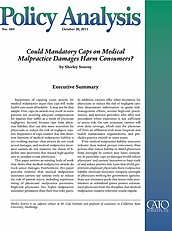This paper reviews an existing body of work that shows that medical malpractice awards do track actual damages. Furthermore, this paper provides evidence that medical malpractice insurance carriers use various tools to reduce the risk of patient injury, including experience rating of physicians’ malpractice premiums. High-risk physicians face higher malpractice insurance premiums than their less-risky peers. In addition, carriers offer other incentives for physicians to reduce the risk of negligent care: they disseminate information to guide riskmanagement efforts, oversee high-risk practitioners, and monitor providers who offer new procedures where experience is not sufficient to assess risk. On rare occasions, carriers will even deny coverage, which cuts the physician off from an affiliation with most hospitals and health maintenance organizations, and precludes practice entirely in some states.
If the medical malpractice liability insurance industry does indeed protect consumers, then policies that reduce liability or shield physicians from oversight by carriers may harm consumers. In particular, caps on damages would reduce physicians’ and carriers’ incentives to keep track of and reduce practice risk. Laws that shield government- employed physicians from malpractice liability eliminate insurance company oversight of physicians working for government agencies. State-run insurance pools that insure risky practitioners at subsidized prices protect substandard physicians from the discipline that medical malpractice insurers otherwise would impose.


